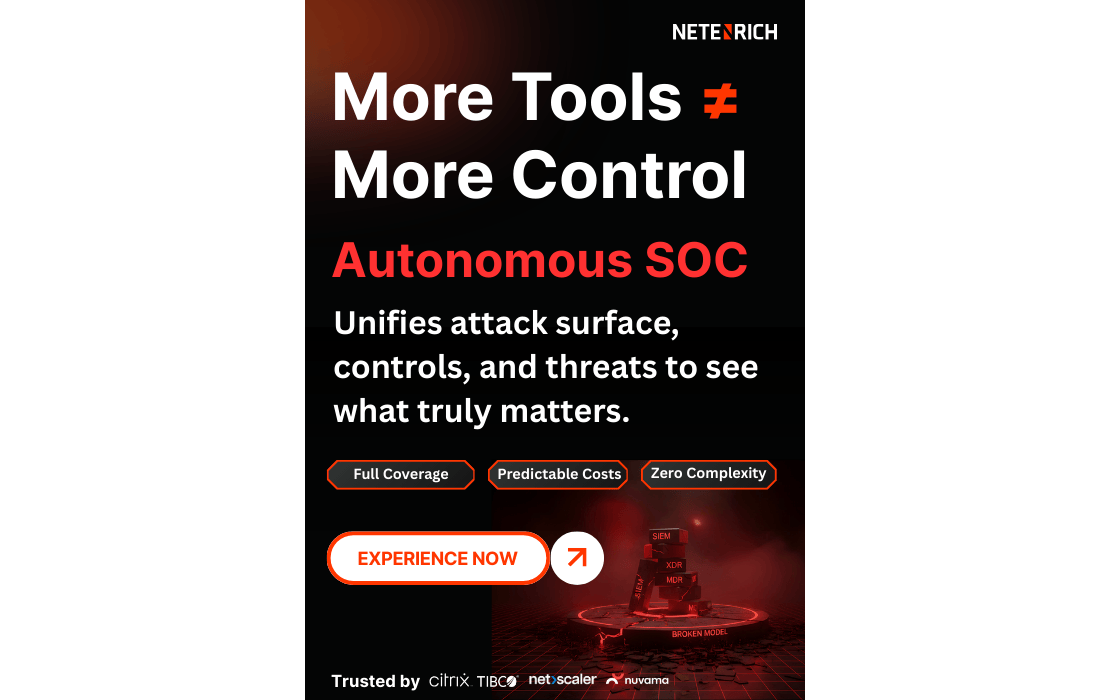Key Takeaways
- SOC analyst burnout stems from overwhelming alert volumes, fragmented workflows, and weak career paths.
- Noise directly drives higher MTTR, missed threats, and rapid turnover.
- Automation clears repetitive triage and enables a tiered SOC model.
- Analysts progress from machine-assisted triage to investigation to strategy.
- The result is faster response, higher retention, and a SOC built for long-term resilience.
The modern Security Operations Center (SOC) is drowning in noise. Each new security tool, from SIEMs to EDRs, brings its own stream of alerts, rules, and dashboards, creating layers of complexity that slow response.
Today, on average, an organization receives approximately 4,484 security alerts per day*. Unsurprisingly, almost half of the alerts go uninvestigated due to a lack of capacity. Analysts spend hours validating signals across disconnected systems instead of focusing on actual adverse behaviour.
And this imbalance between alert load and human capacity is leading to burnout. According to a report by Tines, 71% of SOC analysts report burnout, citing alert fatigue. As a result, average analyst tenure continues to shrink, with some SOCs seeing turnover cycles of less than 18 months.
This constant churn isn't just a staffing headache; it's a critical erosion of institutional knowledge. Every time a seasoned analyst leaves, your SOC’s ability to recognize sophisticated attack patterns weakens, creating blind spots that adversaries are quick to exploit. For the CISO, analyst burnout has become a direct threat to the organization's resilience.
The writing on the wall is clear: A SOC built on manual sorting and outdated tools cannot keep pace with the speed of modern threats. A structural change in the form of automation, AI-driven enrichment, and a tiered SOC model that rebalances the equation between humans and machines is essential.
Diagram showing how multiple security applications generating hundreds to thousands of alerts per day leads to ‘Alert Tyranny,’ overwhelming staff, and causing missed breaches.
The Anatomy of Burnout: A Structural Problem
Burnout in the SOC does not happen overnight. It has clear, structural causes that stem from unmanageable workloads, fragmented processes, and career stagnation.
Analyst workload imbalance
The volume of alerts far exceeds what human teams can handle. With the adoption of cloud technology and tool proliferation, this imbalance only increases.
- A mid-size enterprise with 12 analysts may receive 3,000–5,000 alerts daily.
- If each analyst spends 10 minutes per alert, the team would need 500 hours per day to keep up. This is impossible without automation.
This workload imbalance drowns analysts in noise, guaranteeing that fatigue sets in. This is a math problem that hiring more people alone cannot solve. Underlying it all is the lack of unified context across assets, controls, and threats. Without that alignment, SOCs end up chasing noise instead of managing risk.
Tool and process fragmentation
Most investigations require constant context switching between SIEMs, endpoint tools, firewalls, and ticketing systems. Analysts spend time re-entering data, piecing together logs, and building context by hand. The fragmented workflow slows response, adds cognitive strain, and increases the likelihood of errors under pressure.
An SOC manager voiced a related frustration at the October 2024 CISO Roundtable: “The challenge is ensuring data quality; if the data pipeline is noisy, it affects the AI outputs.”
Career cycle and turnover
SOC roles have some of the highest attrition in cybersecurity. Entry-level analysts often find themselves stuck in repetitive routines with little chance to advance into strategic work.
As a result, many leave within just a few years. In fact, 42% of SOC leaders report that staff tenure is actually shrinking*. The constant churn erodes institutional knowledge and keeps organizations locked in a costly cycle of rehiring and retraining.
How does alert noise contribute to burnout?
False positives and low-value alerts
Roughly two-thirds of daily alerts are false positives or low-priority events that do not map to genuine threats*. Analysts quickly realize they are spending most of their time validating tool output instead of tracking adversary behavior. This mismatch between effort and value fuels dissatisfaction. Analysts want to solve real problems, not chase down noise.
As one CISO put it at the December 2023 CISO Roundtable: “The hardest challenge is ensuring the system learns from the environment without overwhelming users with false positives.”
The High Cost of Constant Context-Switching
Switching contexts across consoles hundreds of times a day creates exhaustion. Over time, analysts become desensitized to alerts, raising the likelihood of missing something serious.
71% of analysts report feeling burned out* due to the endless cycle of manual, repetitive work. This desensitization is dangerous as it lowers vigilance, enabling attackers to exploit stealth.
Operational consequences
As fatigue sets in, it translates directly into organizational risk.
- Mean Time to Resolution (MTTR) rises as analysts waste time on false alerts.
- Low-value tickets crowd out meaningful work, causing critical alerts to be misclassified or missed entirely.
- High turnover leaves analysts stretched so thin that they cannot mount effective responses during real incidents.
How can automation reduce SOC Analyst Burnout?
To understand how automation can reduce SOC analyst burnout, consider a day in their life.
Before Automation
It's 9:00 AM. An analyst logs in and sees hundreds of unfiltered alerts across SIEM and EDR dashboards. They spend 15 minutes validating one suspicious login, flipping between firewall logs, Active Directory, and ticketing tools. After three hours, they’ve closed only 12 false positives, with no real threat investigation done.
After Automation with AI-Driven MDR
At 9:00 AM, the same analyst sees just 6 enriched cases. Low-risk signals have been auto-closed. By 9:15 AM, the analyst is already working on real problems instead of chasing noise.
This is not about saving an analyst 15 minutes on a ticket. It’s about redesigning the entire workflow. The real value of automation, therefore, lies in shifting the SOC operating model from reactive triage to proactive defense. Instead of throwing human effort at every alert, AI in SOC can filter, enrich, and even resolve large portions of routine triage.
Automation isn’t just efficiency; it’s the foundation of a modern SOC architecture that balances machine speed with human judgment. At Netenrich, we call this automating the known – letting machines close out repetitive, low-value alerts so analysts can direct their energy toward the unknown, such as novel attack behavior, strategic defense, and proactive hunts. These are the tasks that require real human judgment.
Tiered operating model
Automation becomes the foundation for a new division of labor that reduces burnout while improving detection and response:
- Machine Tier: AI handles alert ingestion, normalization, and correlation. It cross-references threat intel, evaluates severity, and automatically closes low-risk events.
- Investigator Tier: Human analysts step in only where patterns indicate real adversary behavior. With context provided automatically, investigations start closer to the root cause.
- Strategist/Hunter Tier: Senior analysts focus on proactive threat hunting, simulation, and tuning detection logic, building resilience against evolving attack techniques.
Instead of trapping analysts in low-value triage, this model builds a career ladder. Each level requires progressively more skill, with automation serving as the enabler rather than the replacement.
| Traditional SOC Model | Tiered SOC with Automation |
|---|---|
| Entry Level: Manual alert triage, chasing false positives, repetitive checks. | Machine Tier: AI ingests, correlates, and auto-closes low-risk alerts. |
| Mid-Level: Still bogged down in validation and basic enrichment. | Investigator Tier: Analysts handle enriched cases tied to real threats. |
| Senior-Level: Pulled into firefighting, little time for strategy. | Strategist/Hunter Tier: Focus on hunting, simulations, and detection tuning. |
Human and machine partnership
Neither humans nor machines can secure an enterprise alone. If they work in tandem, they can provide coverage that neither can offer alone:
- Machines: Normalize logs across platforms, enrich cases with threat intelligence, apply correlation rules consistently, and operate faster.
- Humans: Spot anomalies, apply judgment, adapt to new attack methods, and connect technical findings to business risk.
The partnership frees analysts from “alert babysitting” and restores their role as problem-solvers.
How does Netenrich MDR support analyst well-being?
Netenrich’s Adaptive Managed Detection and Response (MDR) is designed with analyst experience as a first-class objective. Its AI-driven foundation provides:
AI-driven enrichment and triage
As a Google Cloud partner, Netenrich MDR employs AI to:
- vFilter low-value alerts.
- Enrich events with asset data, identity context, and threat intelligence.
- Leave only high-fidelity cases for analysts.
Behind this automation is an engineering-led MDR model that continuously tunes detections, parsers, and workflows to improve signal quality over time.
Streamlined workflows
Contextual case information flows directly into ITSM and collaboration tools, and documentation and repetitive administration get automated. This means analysts are no longer stuck copy-pasting and resolving ticket numbers. Netenrich MDR restores focus and gives teams time to unravel real threats and piece together the puzzle of an attack.
Career growth model
The tiered SOC structure creates a linear career path for analysts: Start in machine-assisted triage, graduate to investigative roles, and finally move to strategic threat hunting and modeling.
Instead of being trapped in endless alert handling, analysts have a path to grow. This reframes SOC work from high-burnout churn to long-term professional development.
What results come from reducing burnout?
The benefits of tackling burnout extend well beyond morale. Organizations that implement automation and tiered SOC models see measurable benefits, like:
- Lower MTTR: Automated enrichment and correlation cut hours of manual work, leading to faster response, reducing attacker dwell time.
- Higher retention: Analysts are more likely to stay when their day-to-day work is meaningful and they can see a clear path to professional growth.
- Stronger resilience: Consistent alerts of attacks can enable senior staff to focus on hunting and tuning detections. That shift improves the SOC’s ability to spot and contain sophisticated attacks earlier in their lifecycle.
- Cost efficiency: Lower turnover significantly reduces backfilling expenses, both in terms of recruitment and onboarding. Research data suggests that turnover reduction can save thousands of dollars annually.
The result is a stable SOC that evolves in capability instead of resetting knowledge every few years. For CISOs and boards, the payoff is measurable risk reduction. This means faster containment of threats, consistent response across incidents, and clear evidence that security investments are building resilience.
To sum it up, burnout in the SOC can't be solved with more headcount or another security tool. The problem is structural. Alert noise overwhelms humans, processes are fragmented, and analysts are stuck in a never-ending triage.
The cost of burnout is too high to ignore. Shift from a model that drains your talent to one that develops it. With Netenrich MDR, build a resilient SOC and empower your analysts with the tools to succeed.
References:
https://www.vectra.ai/resources/2023-state-of-threat-detection
https://www.tines.com/reports/voice-of-the-soc-analyst/
https://panther.com/blog/identifying-and-mitigating-false-positive-alerts
Related Articles
Subscribe for updates
The best source of information for Security, Networks, Cloud, and ITOps best practices. Join us.









